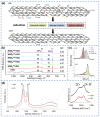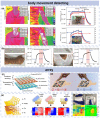Wearable Temperature Sensors Based on Reduced Graphene Oxide Films
- PMID: 37687645
- PMCID: PMC10488796
- DOI: 10.3390/ma16175952
Wearable Temperature Sensors Based on Reduced Graphene Oxide Films
Abstract
With the development of medical technology and increasing demands of healthcare monitoring, wearable temperature sensors have gained widespread attention because of their portability, flexibility, and capability of conducting real-time and continuous signal detection. To achieve excellent thermal sensitivity, high linearity, and a fast response time, the materials of sensors should be chosen carefully. Thus, reduced graphene oxide (rGO) has become one of the most popular materials for temperature sensors due to its exceptional thermal conductivity and sensitive resistance changes in response to different temperatures. Moreover, by using the corresponding preparation methods, rGO can be easily combined with various substrates, which has led to it being extensively applied in the wearable field. This paper reviews the state-of-the-art advances in wearable temperature sensors based on rGO films and summarizes their sensing mechanisms, structure designs, functional material additions, manufacturing processes, and performances. Finally, the possible challenges and prospects of rGO-based wearable temperature sensors are briefly discussed.
Keywords: reduced graphene oxide; temperature sensing; wearable electronics.
Conflict of interest statement
The authors declare no conflict of interest.
Figures






Similar articles
-
Graphene-enabled wearable sensors for healthcare monitoring.Biosens Bioelectron. 2022 Feb 1;197:113777. doi: 10.1016/j.bios.2021.113777. Epub 2021 Nov 10. Biosens Bioelectron. 2022. PMID: 34781177 Review.
-
Freestanding, Fiber-Based, Wearable Temperature Sensor with Tunable Thermal Index for Healthcare Monitoring.Adv Healthc Mater. 2018 Jun;7(12):e1800074. doi: 10.1002/adhm.201800074. Epub 2018 May 11. Adv Healthc Mater. 2018. PMID: 29749708
-
Graphene-Based Wearable Temperature Sensors: A Review.Nanomaterials (Basel). 2023 Aug 14;13(16):2339. doi: 10.3390/nano13162339. Nanomaterials (Basel). 2023. PMID: 37630924 Free PMC article. Review.
-
Robust, Ultrathin, and Highly Sensitive Reduced Graphene Oxide/Silk Fibroin Wearable Sensors Responded to Temperature and Humidity for Physiological Detection.Biomacromolecules. 2023 Jun 12;24(6):2606-2617. doi: 10.1021/acs.biomac.3c00106. Epub 2023 Apr 19. Biomacromolecules. 2023. PMID: 37075303 Free PMC article.
-
Highly Sensitive Bendable and Foldable Paper Sensors Based on Reduced Graphene Oxide.ACS Appl Mater Interfaces. 2017 Feb 8;9(5):4658-4666. doi: 10.1021/acsami.6b10484. Epub 2017 Jan 25. ACS Appl Mater Interfaces. 2017. PMID: 28074645
Cited by
-
All Screen Printed and Flexible Silicon Carbide NTC Thermistors for Temperature Sensing Applications.Materials (Basel). 2024 May 22;17(11):2489. doi: 10.3390/ma17112489. Materials (Basel). 2024. PMID: 38893753 Free PMC article.
References
Publication types
Grants and funding
LinkOut - more resources
Full Text Sources

